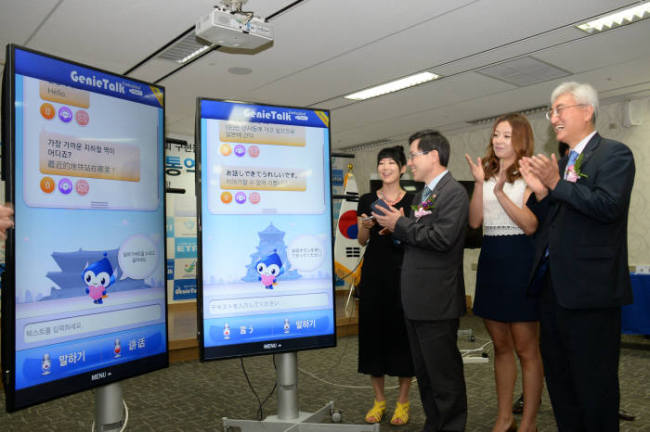Kim Sung-jun, a 30-year-old translator, relies more on the Internet than before to translate technical documents for military equipment. Tasked with books as thick as a dictionary, his trick to quick translation is to run the document through the Internet translation first before tackling the job himself.
“Internet translation service saves time and efforts. Although the quality is not as good as that of translation by humans, it would have consumed twice as much time to translate the whole document without the Internet. The technology has come a long way,” said Kim.
Once thought as a fixture of Sci-fi movie, humankind’s long-held ambition of communicating across language barriers went one-step closer to reality as a series of technology breakthroughs provide the tool that enables them to topple the babel tower -- a biblical reference to language barriers.
One among them is Google Translate. Touted as the most widely used translation service, it covers 90 languages and boasts 500 million users on a monthly basis. Recently, Google rolled out an upgraded version that features translation of real-time conversation and images such as street signs and restaurant menus.
 |
Participants attend an event promoting Seoul government’s interpretation app GenieTalk. Ministry of Science, ICT and Future Planning |
Skype Translator, Microsoft’s recently-unveiled rival to Google Translate, made the headlines with its simultaneous translation service. In the promotion video, an English-speaking student communicates almost flawlessly and simultaneously with a Spanish-native on the other side.
“These technologies were not as fancy as they are now,” said translator Kim. “In the early days, the Internet translation service couldn’t even translate ‘annyeonghaseyo,’ ‘hello’ in Korean, into proper English,” Kim said, referring to the now-defunct prototype translation service Babel Fish.
What brought the breakthrough is the technology called “machine learning,” a computer program that can learn by itself with enough exposure to spoken language. What has changed from previous generations is that the translation quality improves through use, trial and errors.
For example, a translation machine could fail to properly translate “annyeonghaseyo,” into “hello” on the first try. But if the users spot it and fix the error, and get the result incorporated into the machine, it eventually spits out the correct version of translation.
The groundbreaking technology, however, is not enough to translate a complicated sentence full of cultural and historic contexts into the one that sounds natural to native speakers.
On the flip side, the factors that prevent natural translation pose an opportunity to Internet companies who amass stockpiles of data of their native language. Combined with the-more-the-better “machine learning” technology, vast databases contribute to a more natural-sounding translation.
“Since we have more Korean-based data than any other search engines and excellent voice-processing technology that can even make out the difference between Korean homonyms, I think we excel at translation from Korean to English,” said an official from Naver, Korea’s biggest search engine.
Other companies found their way to the solution with social-networking and collective knowledge, a new approach to make up for machine translation’s lack of accuracy in translating documents that require specific knowledge or cultural understanding.
Flitto, a crowdsourcing translation developer, provides users with a forum where they can make a translation request to ideal “human” translators who are classified into different grades that reflect their performance standard such as speed and accuracy among others.
“We are leveraging the talent of average citizens who have excellent language skills. Writing a business letter in foreign language will be a good example as it is a skill that needs good language skill, but not a skill as good as that of professional translators,” said Simon Lee, CEO of Flitto.
Experts in translation industry remain skeptical about the prospect that machines will replace career translators who have extensive experience and special expertise in various fields. They claim that the underlying intent would be lost in translation, regardless of how advanced the technology is.
“Our communication is usually ambiguous and inaccurate. So it is extremely difficult for machines to completely capture connotation behind the expressed language. How could the machines possibly translate simile-ridden literatures?” Kwak Joong-Chol, professor of interpreting at Hankook University of Foreign Studies.
Other experts, such as Suk Jeong-hoon who has worked as professional translator for about 10 years, downplayed the significance of machines’ translation as the technology is all about “prompt” translation, not “accurate” translation, especially of Korean, a language that he considers the most hard-to-translate in the world.
“What is impressive about the translation machines is their speed. But what really matters is what is being translated, not how fast the process is. The machines can only translate basic conversation by those who command perfect grammar, which I think is far from real-life conversation,” said Suk.
“The nature of Korean makes matters worse. Not only is it unique in terms of linguistic structure, but it also has little demand for the language’s translation. Few businesses have ventured into developing translation systems involving Korean as it is apparently not the most sought-after language (in the global translation market),” Suk said.
By Yeo Jun-suk (
jasonyeo@heraldcorp.com)








